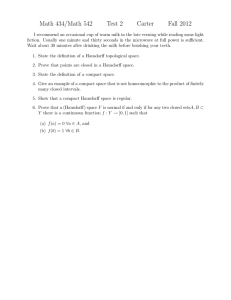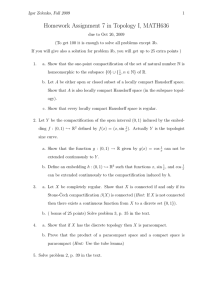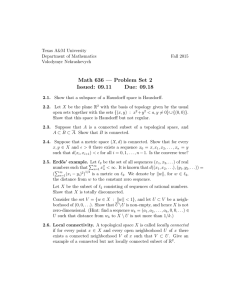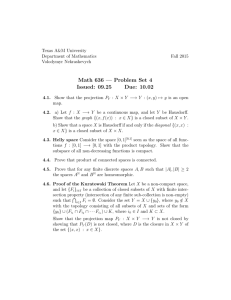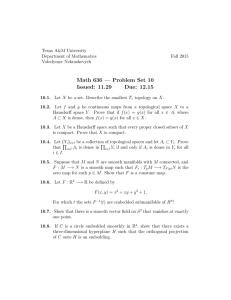Document 13663761
advertisement
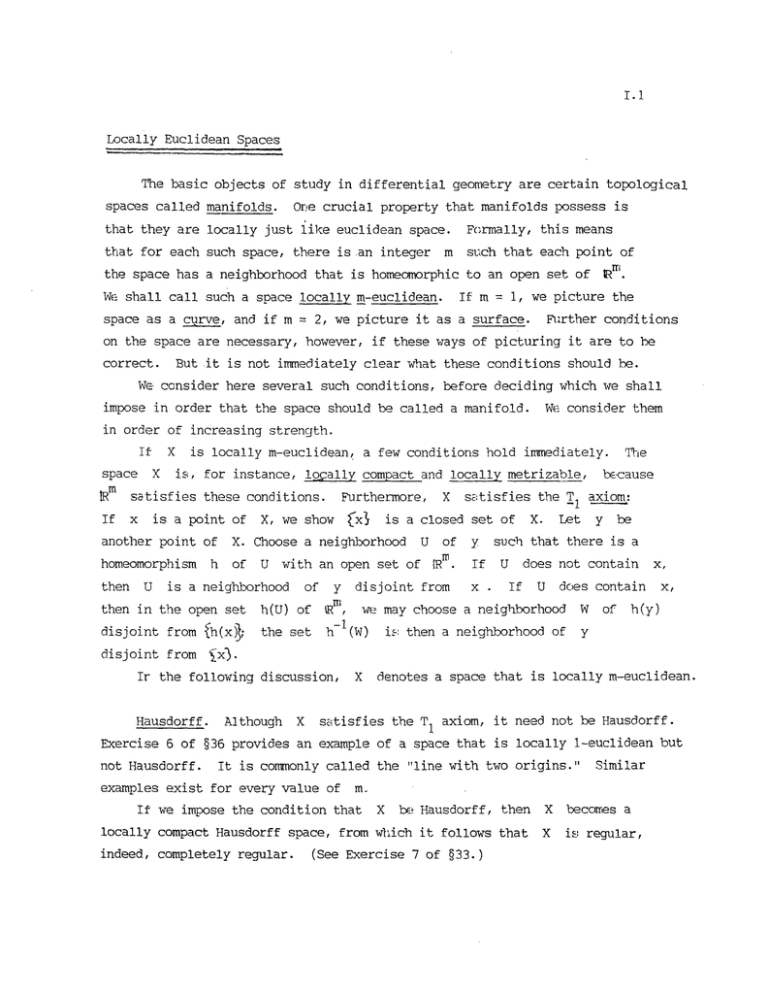
I.1 Locally Euclidean Spaces The basic objects of study in differential geometry are certain topological spaces called manifolds. Oe crucial property that manifolds possess is that they are locally just like euclidean space. Formally, that for each such space, there is an integer such that each point of m this means the space has a neighborhood that is homeomorphic to an open set of We shall call such a space locally m-euclidean. Rm. If m = 1, we picture the space as a curve, and if m = 2, we picture it as a surface. Further conditions on the space are necessary, however, if these ways of picturing it are to be correct. But it is not immediately clear what these conditions should be. We consider here several such conditions, before deciding which we shall impose in order that the space should be called a manifold. We consider them in order of increasing strength. If space X X is locally m-euclidean, a few conditions hold immediately. is, for instance, locally compact and locally metrizable, tRm satisfies these conditions. If x is a point of Furthermore, X, we show jx3 X. Choose a neighborhood homeomorphism of then U U of y then in the open set h(U) of R , disjoint from h(x); the set h disjoint from x). Ir the following discussion, Hausdorff. U with an open set of is a neighborhood Although X stisfies the T is a closed set of another point of h X of R . disjoint from y X. If x . U y be does not contain If U W of x, h(y) y denotes a space that is locally m-euclidean. satisfies the T 1 axiom, it need not be Hausdorff. It is commonly called the "line with two origins." examples exist for every value of -euclidean but Similar m. If we impose the condition that be Hausdorff, then X becomes a locally compact Hausdorff space, from which it follows that X is regular, indeed, completely regular. x, does contain Exercise 6 of §36 provides an example of a space that is locally not Hausdorff. axiom: such that there is a i: then a neighborhood of X because Let we may choose a neighborhood (W) Tlhe X (See Exercise 7 of §33.) 1.2 Normal. that X However, the condition that is normal. X be Hausdorff does not imply Tere is a famous example, called the "Preufer manifold," which is a locally 2-euclidean space that is Hausdorff but not normal. It is discussed in the J section of these notes. Metrizable. In geometry, we should like our spaces to be reasonably nice. In fact, we should like them to be metrizable, or (even better) to be imbeddable as closed sets in some euclidean space EN. Normality is not sufficient, however, for either of these conditions to hold. There is an example called the "long line" that provides a counterexample. locally -euclidean space that is not metrizable. It is a normal, It is discussed in the C section of these notes. Requiring X to be metrizable is in fact equivalent to requiring it to, paracompact and Hausdorff. For every metrizable space is paracompact and Hausdorff (by Theorem 41.4), while a paracompact Hausdorff space that is locally metrizable is metrizable (by Theorem 42.1). Hausdorff with a countable basis. Requiring X to be metrizable still does not ensure that it can be imbedded in euclidean space. the product space R xJ, whIere J Fcr example, is uncountable and has the discrete topology, is locally 1-euclidean and metrizable, but cannot be imbedded in euclidean space (since it has no Since X countable basis). is locally comppct, requiring X to be Hausdorff with a countable basis will ensure that it is metrizable, by the Urysohn metrization theorem. It will in fact ensure that X can be imbedded in N for some compact case is easy and is dealt with in §36; the general case work N The .requires more (See Exercise 7 of §50). These facts lead to the following definition: Definition. The locally m-euclidean space X is called an m-manifold if it is Hausdorff with a countable basis. Now in fact the condition of being Hausdorff with a countable basis is not really much stronger than the condition of metrizability. m-euclidean space X i metrizable, then each component of For if the locally X is an I. .3 m-manifold. This follows from Exercise 10 of §41, which is incorrect as it stands, but is made correctby replacing "paracompact" by "metrizable." Compact Hausdorff. The strongest of the additional conditions one might impose on a locally m-euclidean space These conditiorsimply that in turn implies (since X X X is that it be compact.andHausdorff. is metrizable, by Exercise 7 of §34; this is compact) tat X has a countable basis, by Exercise 3 of §34. The condition of being compact Hausdorff is, however, stronger than we wish to impose in general, for it would exclude many useful spaces, such as IR itself, from consideration. Compact manifolds are, however, particularly nice spaces to deal with; so we are delighted when compactness is satisfied. Proving theorems in the non-compact case often requires more effort. imbedding theorems of 50 are a good example. of this situation. The
